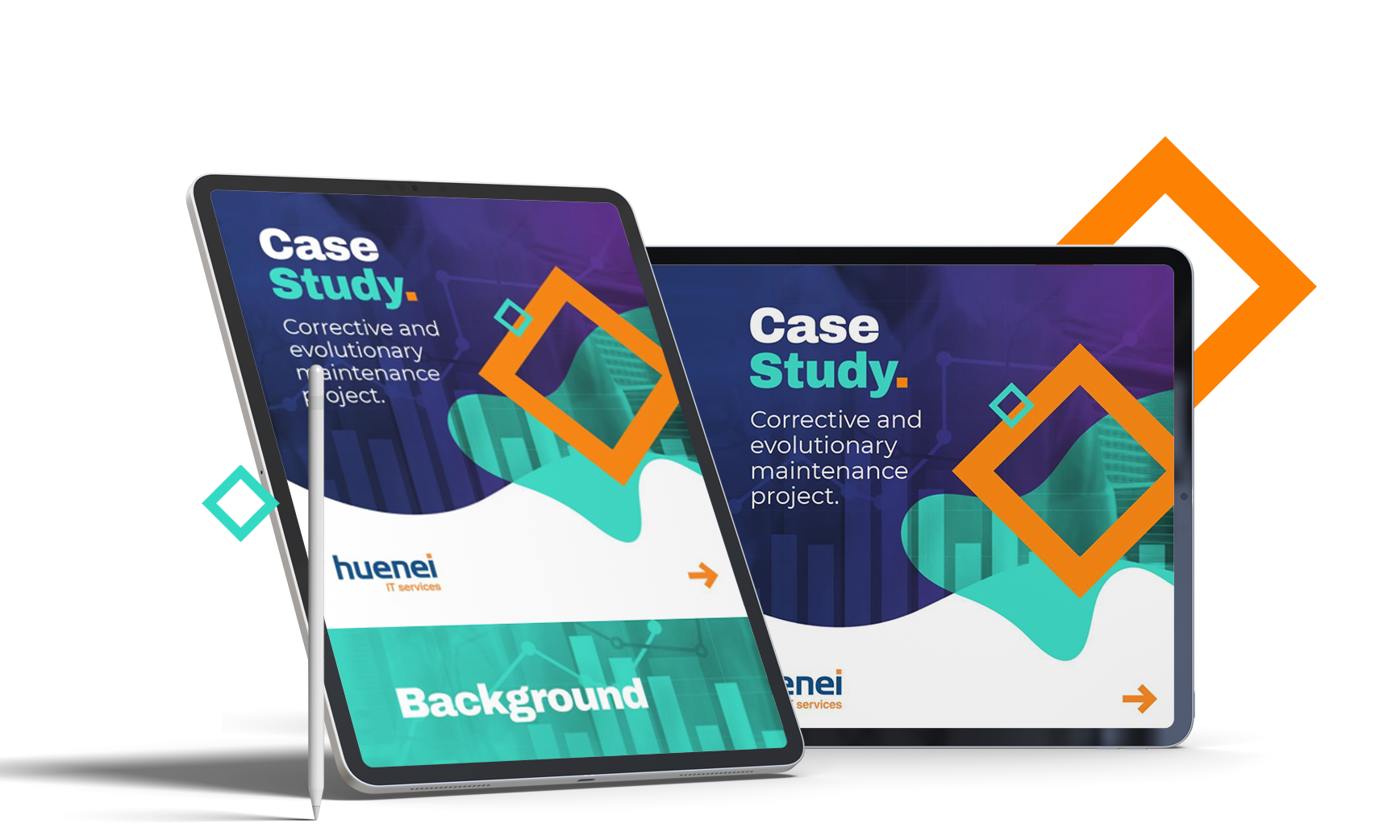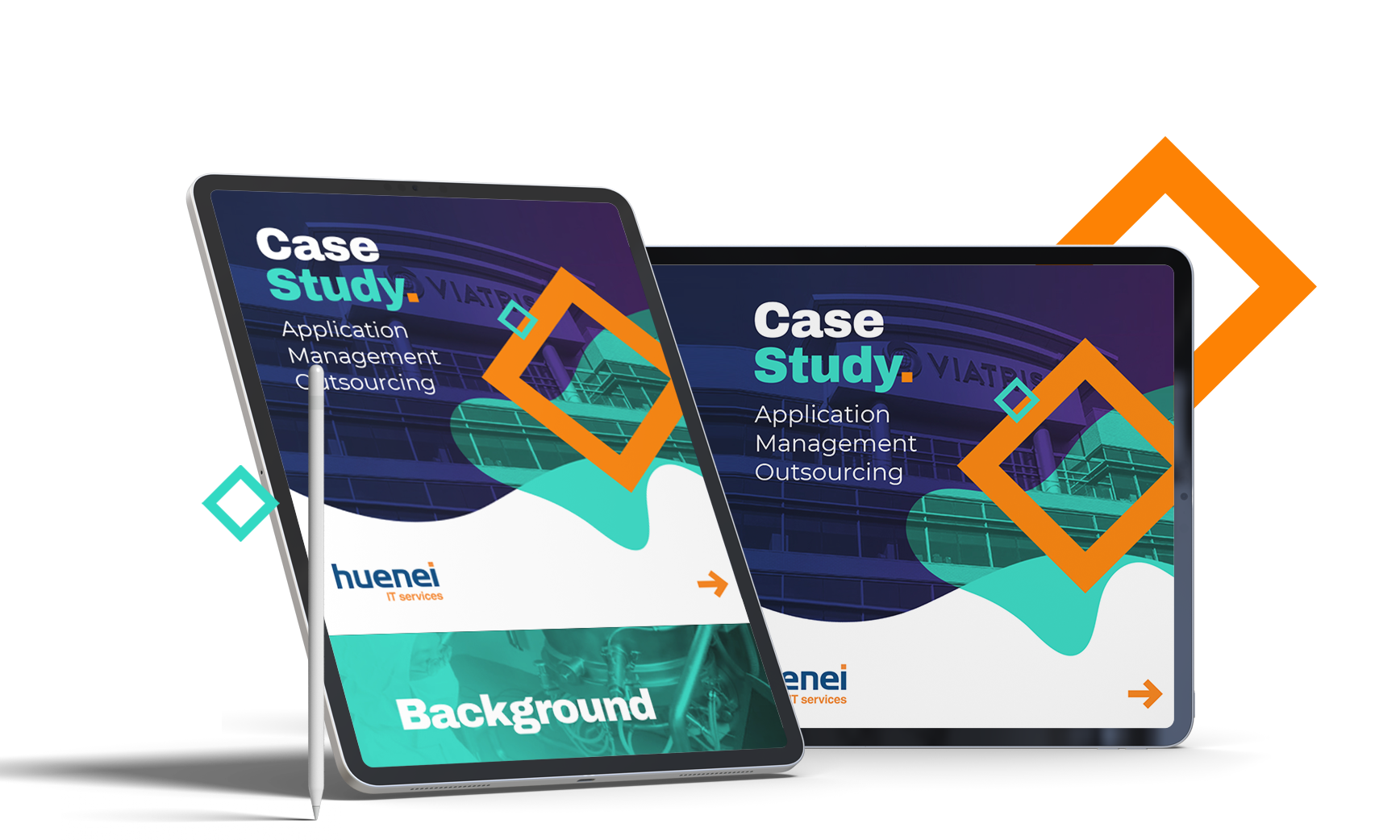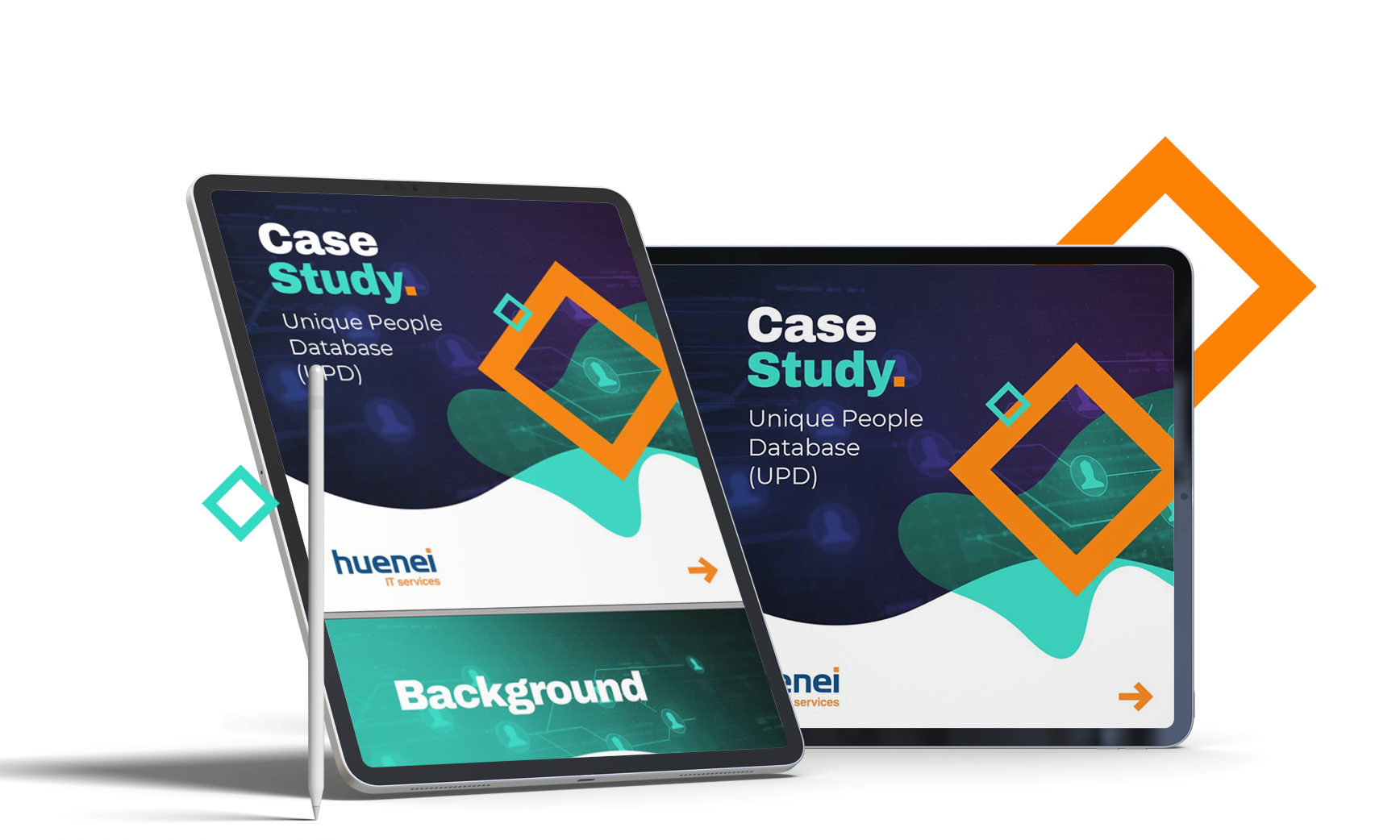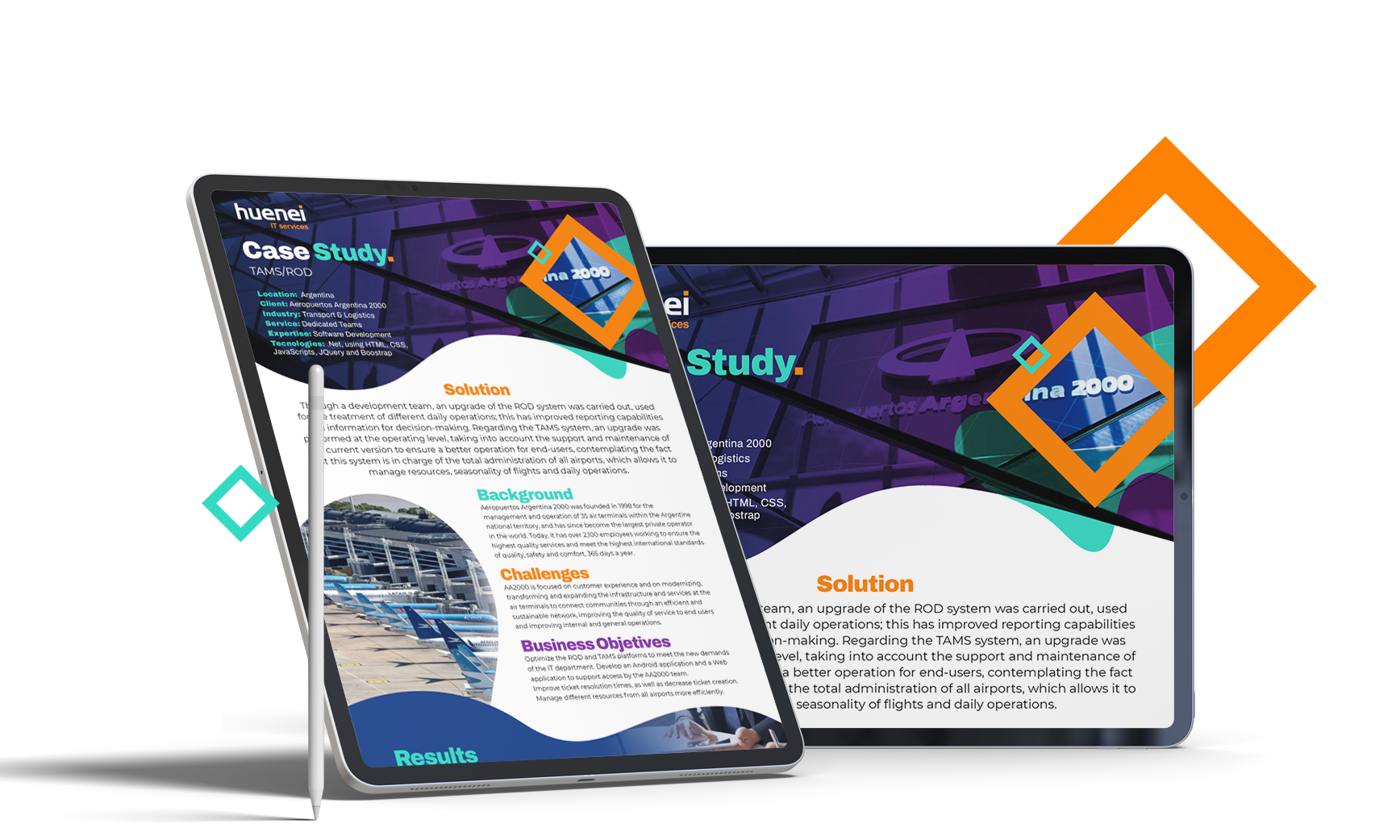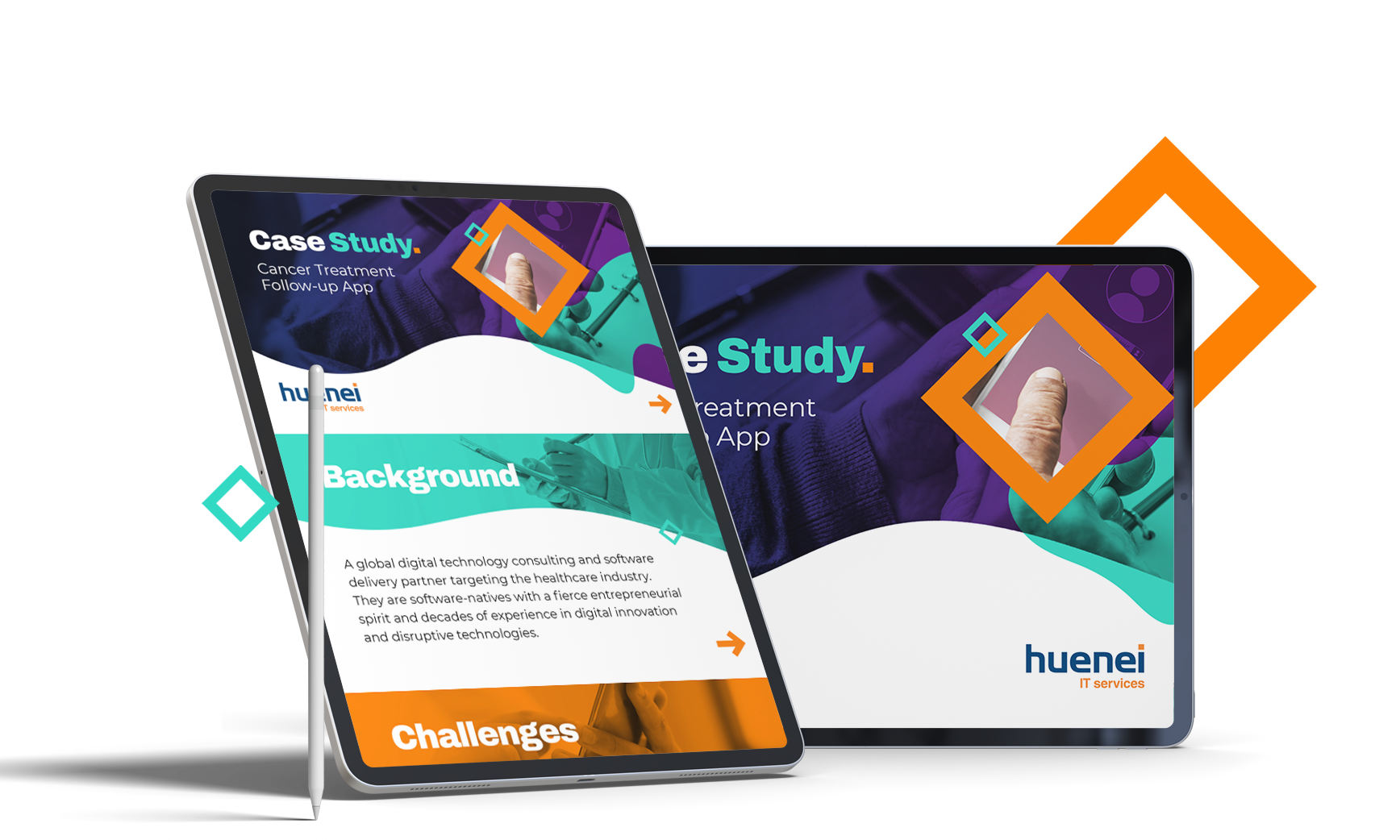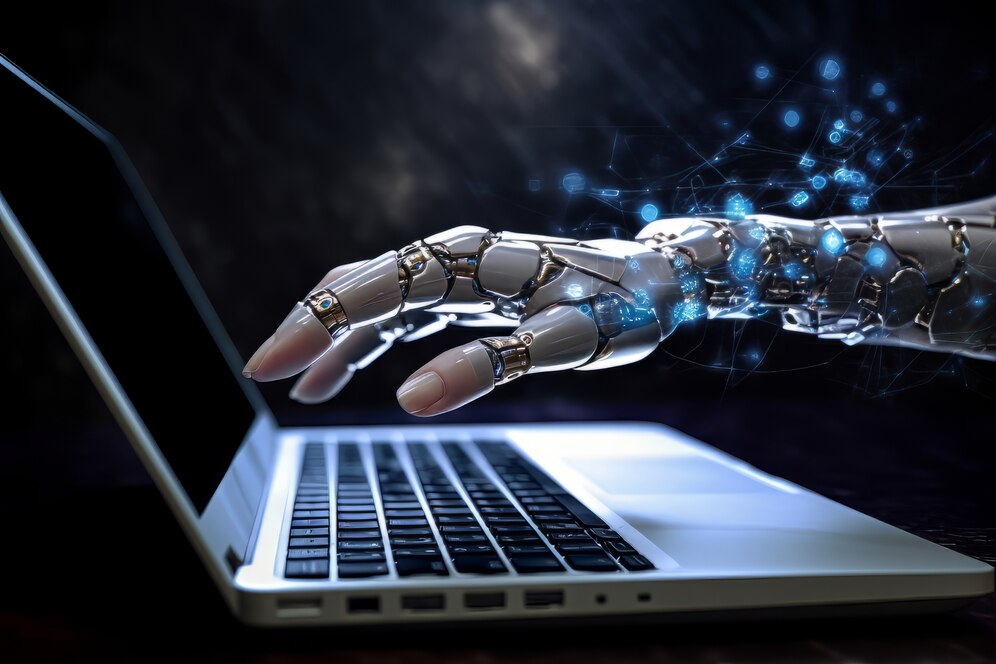
by Huenei IT Services | Apr 8, 2024 | Artificial Intelligence, Software testing
The software industry is a relentless sprint.
Development teams face ever-increasing pressure to deliver high-quality solutions at breakneck speed. Traditional testing methods, however, can be slow and cumbersome, acting as a bottleneck in your agile workflow.
At Huenei, we understand this challenge. That’s why we’ve harnessed the power of Artificial Intelligence (AI) to revolutionize our software testing processes. We can help you do the same.

“AI-powered testing tools have been a game-changer for our teams,” says Alejandra Ochoa, Service Delivery Manager at Huenei. “By automating and optimizing various aspects of the testing lifecycle, we’ve been able to significantly reduce the time and effort required to ensure the quality of our software solutions.”
Accelerating Test Automation with AI
One of the key benefits we’ve experienced is the ability to create airtight automated tests up to five times faster than traditional methods. We leverage advanced algorithms and natural language processing (NLP) capabilities, allowing our developers and testers to write automated tests in plain English. This NLP-based scripting approach simplifies the test authoring process and promotes collaboration among team members with varying technical backgrounds.
“The NLP-based scripting feature has been a game-changer for our agile teams,” Ochoa explains. “Our testers can now focus on testing scenarios and leave the technical implementation details to the AI-powered tools, resulting in more efficient and effective test coverage.”
With this remarkable effort decrease in automatic test case generation, we’re empowered to seamlessly integrate automated testing right from Sprint #1 for all new application developments. Plus, as the Sprints unfold, we can effortlessly expand test coverage, ensuring superior quality and coverage every step of the way. And even more benefits, once the software application has been ended, we have full automated testing coverage!
Streamlining Test Execution and Error Detection
But the benefits don’t stop there. AI-powered testing tools have also optimized test execution, reducing build times from hours to minutes. This efficiency translates into faster feedback loops, allowing our development teams to identify and address issues more promptly, ultimately speeding up the delivery of high-quality software solutions to our clients.
Moreover, these tools excel at identifying and diagnosing functional and visual errors that may have gone unnoticed by human testers. By analyzing vast amounts of data and recognizing patterns, AI-powered testing solutions can catch even the most subtle defects, ensuring a more robust and reliable software product for our clients.
Embracing AI in Agile Testing
At Huenei, we’ve fully embraced the integration of AI in our software testing processes, recognizing its potential to enhance our agile development methodologies. From data-driven testing to cross-platform compatibility testing, AI-powered tools provide comprehensive capabilities that enable our teams to work more efficiently and deliver superior results.
“One of the key advantages of AI in our agile testing processes is the ability to continuously learn and adapt,” Ochoa notes. “As AI-powered tools process more data and encounter new scenarios, they refine their algorithms and improve their testing strategies, resulting in more effective and efficient testing over time.”
Empowering Teams with Intelligent Solutions
At the core of our approach is the belief that AI should empower our teams, not replace them. While AI-powered testing tools automate and optimize many aspects of the testing process, human expertise and oversight remain crucial. We strike a balance between leveraging AI capabilities and ensuring that our developers and testers are actively involved, providing valuable insights and making critical decisions.
“We prioritize responsible and trustworthy AI practices,” Ochoa emphasizes. “Our ethical guidelines and principles ensure that our AI-powered testing tools are developed and deployed with fairness, accountability, and transparency in mind.”
By harnessing the power of AI in our software testing processes, we unlock new levels of efficiency, quality, and agility.

by Huenei IT Services | Mar 4, 2024 | Software development
The Dawn of a New Digital Era
The metaverse represents an unprecedented convergence of technologies that promises to fundamentally reshape the digital landscape. By combining cryptocurrency, AI, AR/VR, and spatial computing into expansive virtual worlds, the metaverse has the potential to revolutionize entertainment, commerce, communication, and even the nature of work itself.
For technology leaders and builders, this new digital frontier presents bountiful opportunities – as well as complex challenges. To successfully navigate this uncharted territory, organizations must craft thoughtful strategies, assemble specialized teams, and invest in developing the required capabilities.

The State of the Metaverse
While still in its nascent stage, the metaverse ecosystem already has some clear leaders staking their claims. Tech giants Meta, Microsoft, Google, and Tencent have made major investments, attracted by gaming, social, and commercial applications. Upstarts like Roblox and Epic are pioneering new models of immersive user-generated worlds and virtual events.
But the borders are not yet defined. The coming years will see intensifying competition, continued disruption of traditional business models, and new players entering the arena. The technology leaders who can capitalize on this uncertainty – by building adaptive, user-focused applications powered by interoperability and emerging tech – stand to shape the infrastructure of the metaverse.
Strategic Considerations
When approaching the metaverse, technology leaders should ground initiatives in clear business goals and market realities while allowing room for experimentation.
Discover New Revenue Streams
Virtual goods, in-app purchases, and other models can drive real monetization of digital experiences and assets. Nike, for example, sold $185 million of virtual products in 2021. With users spending more time and money in immersive environments, new markets around digital content creation, advertising, and commerce abound.
Enhance Operational Agility
Digital twins of factories and supply chains are improving manufacturing flexibility, streamlining deployments, and optimizing productivity. Automakers like BMW are simulating entire vehicle development cycles in virtual environments prior to physical production.
Reinvent Brand Interactions
Brands like Starbucks are leveraging VR, AR and gamification to blend digital and physical engagement. By providing value, entertainment and community, companies can gain deeper customer loyalty.
Future-Proof Product Design
In an ecosystem centered on interoperability and accessibility, products must evolve to meet users across platforms ranging from VR headsets to mobile devices. Build with open standards in mind.
Build Your Tribe
Realizing the promise of the metaverse requires multidisciplinary talent combining software engineering, UX design, 3D graphics, security, and technical infrastructure skills. Training programs, strategic partnerships and acquisitions may help secure capabilities.
Maximize Value, Minimize Risk
Approaching innovation with clear goals and guardrails in place helps ensure positive outcomes. Prioritize designs that promote user autonomy, choice, security and privacy.
“As the metaverse becomes more embedded into the fabric of society, it may start to merge more with the physical world. Companies should approach this proactively today with flexible strategies rooted in solving real problems for customers, rather than reactive plans built around technological fads that may be short-lived.”
Jorge Attaguile
The Tools and Tech Powering the Metaverse
While the metaverse leverages familiar game development platforms like Unity and Unreal Engine, effectively engineering the next generation of immersive and interconnected virtual worlds requires mastering emerging skill sets spanning a range of critical domains.
Developers must integrate decentralized Web3 protocols enabling user-owned assets, permissions, and tokenized incentives. They need to build real-time 3D experiences optimized for AR, VR, and mixed-reality hardware of all types, powered by spatial computing and reactive to user input. Multiplayer networking architecture ensuring high scalability and low latency communication between users is essential as virtual spaces grow more collaborative. Expertise in creating highly detailed 3D digital assets, characters, and environments using tools like Blender and Autodesk Maya gives life to synthetic worlds. Incorporating AI and generative design allows the automatic production of content attuned to individual user preferences. And simulation technology replicating factories, cities and whole supply chains accelerates prototyping and reduces physical world testing requirements. Though anchored on long-standing graphics engines, assembling a complete, living metaverse requires weaving together infrastructure at the cutting edges of these disciplines.
Success in Metaverse development requires a diverse skill set encompassing programming languages, 3D graphics, networking, user experience design, and security. Developers should continuously adapt and learn new technologies to stay ahead in this rapidly evolving field.
The Road Ahead
The coming years will prove foundational in mapping out our emerging virtual geography. While challenges are plentiful, few technical frontiers have promised such a breadth of opportunities for innovation and human collaboration. By embracing this new frontier with sound strategy, focused investment, and an eye toward solving real user needs, today’s technology trailblazers can play a leading role in shaping our shared virtual future.
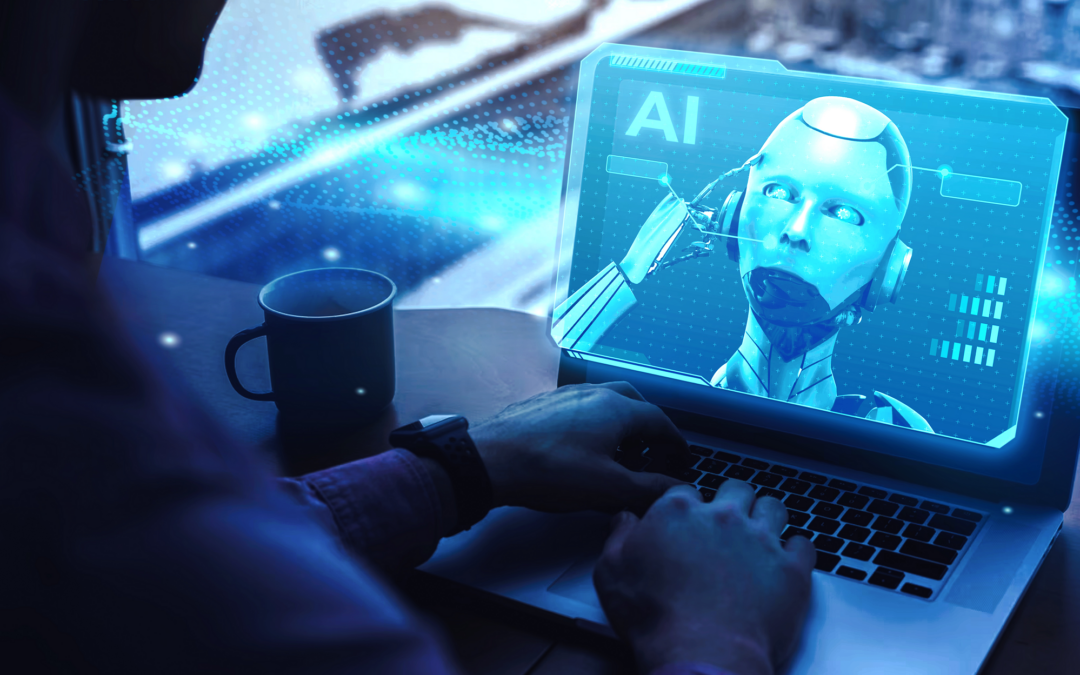
by Huenei IT Services | Mar 4, 2024 | Artificial Intelligence
The rise of conversational chatbots and virtual customer assistants provides a tantalizing promise for the future of automated customer support.
Yet the vast majority of chatbots and AI-powered conversational tools still struggle to move beyond their narrow scripted domains. But what if AI could go deeper? While chatbots have been instrumental in automating basic customer interactions, Generative AI expands the horizon, offering a plethora of applications beyond scripted responses.
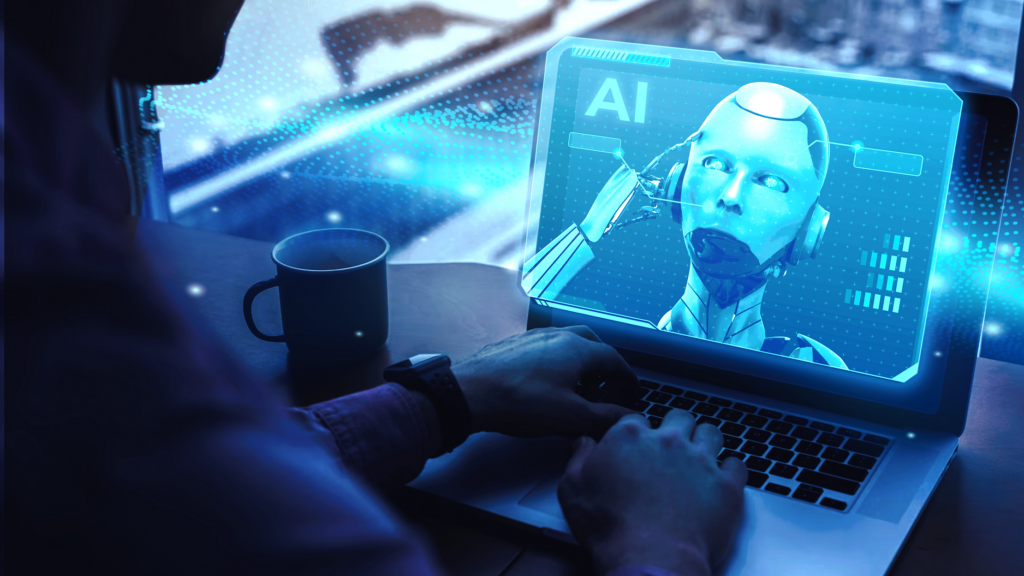
Real-world Applications
Let’s take a closer look at how GenAI is reshaping customer support across various industries:
- Automated Ticket Routing: Analyze support ticket details and descriptions to instantly determine the correct assignment routing – whether that’s to a specialist team, specific agent, or automated workflow. Accurately routing higher volumes of tickets serves to dramatically improve overall response times.
- Knowledge Enhancement: Generate contextual knowledge articles, product support pages, and FAQs tailored to precise customer scenarios and pain points. Continually publishing hyper-focused content then creates a powerful information foundation for both customers and agents.
- Response Acceleration: Generate instant personalized draft responses for customer inquiries and issues by ingesting and analyzing historical interactions and resolution data. Agents then simply review and finalize responses while enjoying huge productivity gains.
- Automation Expansion: Streamline low-complexity tasks such as order status checks, refund requests, and appointment scheduling entirely through automated generative conversations. This frees agents to focus on the most complex – and rewarding – customer interactions.
Generative AI Revolutionizing Support
Gen AI and associated techniques sit at the heart of the next era of customer support innovation. As Jorge Attaguile, Founder and COO of Huenei, explains:
“We are working on various initiatives with Generative AI. Our proposal would help in the customer service process, streamlining response times through task automation. Developments vary according to each client’s needs.”
Imagine a scenario where farmers require immediate assistance regarding crop management or supply chain queries. Our ongoing initiative in the agricultural sector leverages Generative AI to provide swift and personalized responses to customer inquiries. By analyzing historical data and tailoring responses to individual needs, Generative AI enhances customer satisfaction while freeing up valuable time for human agents to focus on complex tasks.
In the insurance sector, time is of the essence, especially when addressing policy inquiries or claims processing. Through task automation, Generative AI streamlines low-complexity tasks such as appointment scheduling and FAQ responses. This not only accelerates response times but also enhances operational efficiency, allowing agents to allocate resources towards high-value activities.
In the pharmaceutical sector, where compliance and accuracy are paramount, Generative AI serves as a valuable resource for human agents. By providing real-time suggestions and resources, Generative AI assists agents in resolving complex customer issues efficiently. Whether it’s navigating regulatory policies or recommending product information, Generative AI empowers agents to deliver superior customer service with confidence.
The impacts of implementing AI across the customer support function are multifaceted and compelling. By ingesting historical customer interactions and resolution data, AI can draft personalized responses in real time, accelerating the speed of resolution by 33% on average. Simultaneously, generative models can process up to 5 times the volume of support tickets compared to human-only teams, ensuring more customers get timely responses. This combination of faster response velocities and higher volumes directly correlates with sky-high 89% customer satisfaction scores from early adopters. Teams leveraging AI-generated draft responses also see a 45% increase in first-contact resolution rates – reducing costly back-and-forth exchanges. With more customer issues resolved instantly via personalized self-service conversations, call volumes decrease by up to 18% – further optimizing support costs. The numbers speak for themselves – generative AI delivers better, faster, and more cost-efficient customer experiences.
As Attaguile summarizes, “Generative AI can significantly improve the customer service process by providing quick, personalized, and empathetic responses, as well as automating repetitive tasks.”
Recommendations for Action
To actively explore the transformative potential in customer support, consider the following recommendations:
Evaluate Your Current Workflow: Conduct a thorough assessment of your existing customer support workflow to identify areas where Generative AI can drive tangible improvements.
Pilot Projects and Proof of Concepts: Initiate pilot projects or proof of concepts to gauge the feasibility and effectiveness of Generative AI solutions within your organization.
Collaborate with AI Experts: Partner with experienced AI vendors or consultants who specialize in Generative AI to leverage their expertise and ensure successful implementation.
Continuous Monitoring and Optimization: Continuously monitor and optimize Generative AI solutions to align with evolving customer needs and business objectives, ensuring sustained success in customer support initiatives.
In conclusion, Generative AI represents a paradigm shift in customer support, offering unparalleled opportunities to enhance efficiency, improve customer satisfaction, and drive tangible ROI. By transcending the limitations of traditional chatbots and embracing innovative applications, organizations can elevate their customer service experiences to new heights. Embrace the power of Generative AI today and revolutionize your approach to customer support in the digital age.

by Huenei IT Services | Feb 1, 2024 | Artificial Intelligence
A recent McKinsey study revealed groundbreaking productivity potential from pairing developers with generative AI tools. Test developers saw coding tasks completed up to twice as fast across refactoring, new feature building, and code documentation.

The gains come from generative AI supercharging developers in 4 key areas:
- Expediting manual and repetitive coding work through autocompletion and documentation
- Jump-starting new code drafting with on-demand suggestions
- Accelerating updates to existing code by easing edits
- Enabling developers to tackle unfamiliar challenges with framework guides and snippets
Leading AI coding assistants like GitHub Copilot, TabNine, and Codex allow developers to generate code snippets and entire functions through conversational prompts, drastically accelerating rote programming work. Developers retain oversight to evaluate quality and customize outputs. While focused on Python currently, experts predict advances across languages and platforms. Though optimal use cases differ. Java and C# projects have seen 10-30% shorter timelines leveraging automation for routine changes. Accelerated coding paves the way for faster release cycles, reduces costs, and frees up resources to focus on innovation. But responsible implementation is key amid rising adoption. Organizations must mitigate risks around data privacy, security vulnerabilities, and reputational impacts through governance policies and controls. Upskilling developers on generative AI best practices also improves experience, and retention while maximizing productivity gains. The future is bright for symbiotic human and AI collaboration in software engineering. With disciplined adoption, generative AI unlocks speed, cost savings, and creativity for transformative gains.
Testing First-Hand
So far, we have analyzed how the IT industry is leveraging AI to its advantage. But can we assure that everything described above is true? At Huenei, we incorporated the use of AI tools very early on. Given the promising landscape they offer and the technological revolution they entail, we could not refrain ourselves and had to give it a try. The incorporation of AI into our processes has helped streamline our and our client’s productivity. Through the use of Copilot, the autocomplete tool created by GitHub in partnership with OpenAI, we have managed to make code-writing tasks more efficient. Based on previously generated code, Copilot can autocomplete code lines or blocks. The decision to incorporate it was based on the good metrics achieved, with 40% of its Python suggestions being accepted by developers. It is important to keep in mind that developer intervention will always be necessary to avoid risks due to errors. AI has also assisted us in the process of executing unit tests, saving time and resources. Machine learning algorithms can analyze code and automatically generate test cases quickly, identifying possible scenarios and generating relevant data, reducing manual workload and accelerating the process. We have achieved optimization of unit testing by identifying areas of code prone to errors, allowing us to focus our efforts on critical flows. Similarly, code analysis provides us with recommendations on areas to expand testing coverage. By gathering and preparing test data, we have implemented a model that aligns with existing processes. The constant training and monitoring help guarantee risk mitigation. The results have been excellent. Leveraging intelligence represented an exciting opportunity to enhance the efficiency and quality of software development through automation, increasing the reliability of outcomes and reducing costs of the end product.
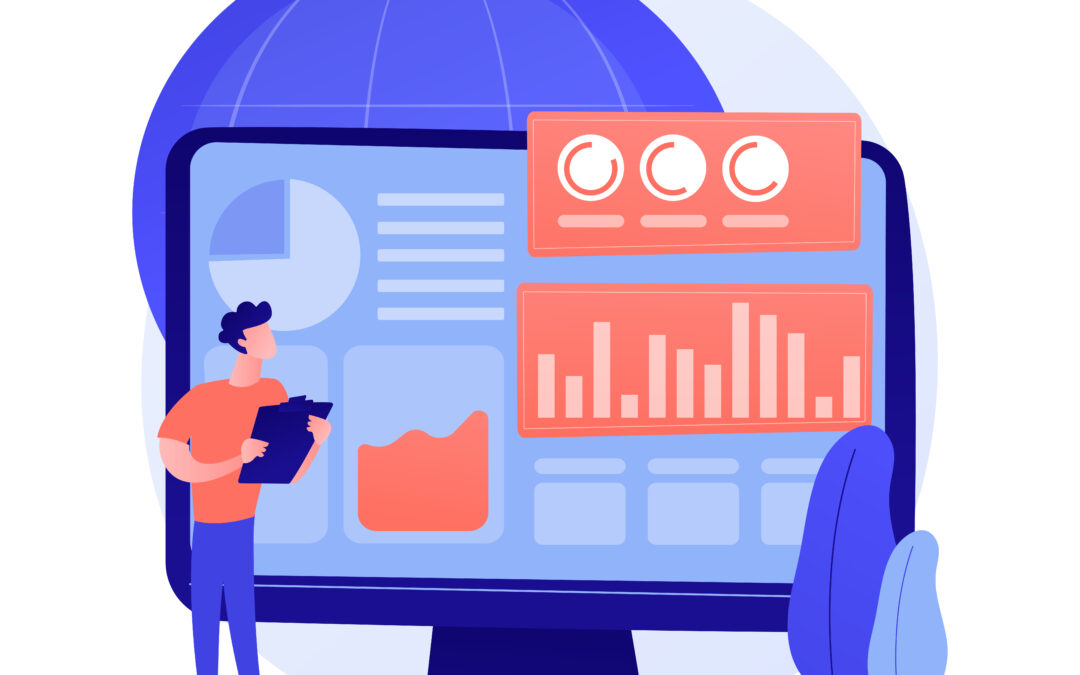
by Huenei IT Services | May 9, 2023 | Artificial Intelligence
Predictive analytics powered by artificial intelligence have immense potential to revolutionize healthcare and other industries.
By analyzing vast amounts of patient data, AI algorithms can identify individuals at risk for certain diseases and predict which treatments will be most effective for each patient. In this article, we explore how AI-enabled predictive analytics tools can help healthcare organizations achieve key objectives.
Detecting Diseases Earlier
One major healthcare goal is detecting diseases at the earliest stages when they are most treatable. AI predictive analytics support this mission by pinpointing patients likely to develop illnesses based on risk factors in their data. Doctors can then take preventative action with lifestyle changes or early interventions before diseases progress, improving outcomes.
Improving Patient Outcomes
Healthcare aims to enhance patient outcomes. AI predictive analytics support this by forecasting how patients will likely respond to different treatments. Doctors can then customize treatment plans to each patient’s predicted needs, boosting the chances of successful therapies.
Reducing Costs
Lowering healthcare expenses is a constant pursuit. AI predictive analytics curb costs by reducing ineffective therapies. Algorithms analyze patient data to determine optimal treatments, avoiding expensive trial-and-error approaches.
Enabling Personalized Medicine
Precision medicine is rising, with treatments tailored to individuals. AI predictive analytics are key, assessing genetics, lifestyles, and health histories to create personalized plans. This leads to more targeted, effective care.
Boosting Population Health
AI predictive analytics also identify health trends across populations by processing large datasets. Providers can then develop focused interventions to boost community-wide outcomes.
At Huenei, we specialize in ethical, privacy-focused AI development including predictive analytics. Our solutions enable organizations to leverage AI while protecting patient data through strong security policies. Contact us today to explore how our AI expertise can help your healthcare organization pursue vital goals.









